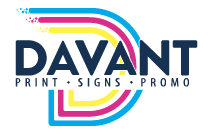Print marketing has been a cornerstone of business communication for centuries, evolving alongside technology, consumer behavior, and market demands. From its early days as simple handbills to today’s high-tech, interactive designs, print has remained a reliable and powerful tool for businesses to connect with their audiences. At Davant Indy, we’ve been at the forefront of this evolution, helping businesses in Greenfield and Central Indiana adapt their print strategies to meet the needs of the modern market.
So, come along as we explore the rich history of print marketing, its transformation over the years, and the cutting-edge techniques shaping its future.
The Origins of Print Marketing: A Historical Perspective
Print marketing as we know it began in the late 15th century with the invention of the printing press. This groundbreaking technology made it possible to produce flyers, posters, and pamphlets, which businesses used to promote their products and services. By the 18th and 19th centuries, newspapers and magazines became popular platforms for advertising, giving rise to mass marketing.
While these early techniques may seem basic by today’s standards, they laid the groundwork for modern print marketing. Key elements like compelling copywriting, bold visuals, and strategic placement all began during this era.
The Rise of Traditional Print Marketing
The 20th century marked the golden age of print marketing. Newspapers, magazines, and direct mail became the dominant mediums for reaching consumers. Businesses invested heavily in print ads, understanding that these materials were tangible and had staying power—qualities that are still relevant today.
Key techniques of this era included:
- Mass Distribution: Print ads reached large audiences through newspapers and magazines.
- Eye-Catching Design: Bold headlines, creative illustrations, and striking imagery captured attention.
- Direct Mail Campaigns: Businesses sent personalized letters and catalogs straight to consumers’ homes, laying the foundation for today’s direct mail strategies.
Despite the dominance of traditional methods, this era was not without its challenges. Print marketing requires significant resources and time, making it less accessible for smaller businesses.
The Impact of the Digital Revolution
The late 1990s and early 2000s saw the rise of the Internet and digital marketing. Many predicted that digital platforms would render print obsolete. While it’s true that digital marketing changed the landscape, print marketing didn’t disappear—it adapted.
Businesses began integrating print with digital campaigns, creating a symbiotic relationship between the two. For example:

- Print Ads with QR Codes: These allowed readers to access websites or promotions instantly by scanning a code.
- Email and Direct Mail Pairings: Businesses sent follow-up emails to reinforce the messaging of physical mailers.
- Augmented Reality (AR): Some print pieces incorporated AR elements, offering interactive experiences that bridged the gap between print and digital.
Rather than being replaced, print marketing found new ways to thrive alongside its digital counterparts.
Modern Print Marketing: Where We Are Today
Today’s print marketing is smarter, more targeted, and more innovative than ever. Advances in technology have unlocked new possibilities, allowing businesses to create materials that are not only visually stunning but also highly personalized.
Here’s what modern print marketing looks like:
Personalization at Scale
Modern printing techniques, like variable data printing, make it possible to customize every piece of a campaign. Whether it’s adding a recipient’s name or tailoring content to specific demographics, personalization creates a stronger connection with audiences.
Sustainable Practices
Today’s consumers care about sustainability, and businesses are responding by choosing eco-friendly materials and processes. Recycled paper, soy-based inks, and green certifications are now standard in print marketing.
Tactile Experiences
One thing digital can’t replicate is the feel of print. Businesses are leveraging tactile elements like embossed logos, soft-touch finishes, and metallic accents to create memorable experiences for their customers.
Interactive Elements
Print is more dynamic than ever. QR codes, AR technology, and NFC-enabled materials make it easy for consumers to engage further with a brand online, extending the impact of print campaigns.

Looking to the Future: What’s Next for Print Marketing?
Print marketing is constantly evolving, and we’re excited about what the future holds. As technology continues to advance, we expect to see even more integration between print and digital, making campaigns more seamless and impactful. AI-driven design tools, 3D printing techniques, and even more sustainable materials are just a few innovations on the horizon.
At Davant Indy, we’re committed to staying ahead of these trends to provide our clients with the best solutions for their needs. Whether you’re looking to enhance your direct mail campaigns, create signage, or explore cutting-edge printing techniques, we’re here to help.
Why Print Marketing Still Matters
In an increasingly digital world, print marketing stands out because of its tangible, human touch. A beautifully designed brochure, a thoughtfully written postcard, or a luxurious business card can create a lasting impression that digital alone can’t achieve. Print is more than just ink on paper—it’s an experience, a connection, and a representation of your brand’s value.
Let’s Write the Next Chapter Together
The evolution of print marketing has been a journey, and we’re proud to be part of it. At Davant Indy, we bring decades of experience and a passion for innovation to every project we take on. Whether you’re a small business in Greenfield or a growing company in Central Indiana, we can help you navigate the changing landscape of print marketing and create materials that resonate with your audience.
Ready to elevate your print marketing in 2025? Contact us today to get started—we can’t wait to bring your vision to life!

